AMX Epica DGX 288 Enclosure Handleiding
AMX
Niet gecategoriseerd
Epica DGX 288 Enclosure
Bekijk gratis de handleiding van AMX Epica DGX 288 Enclosure (2 pagina’s), behorend tot de categorie Niet gecategoriseerd. Deze gids werd als nuttig beoordeeld door 48 mensen en kreeg gemiddeld 4.4 sterren uit 24.5 reviews. Heb je een vraag over AMX Epica DGX 288 Enclosure of wil je andere gebruikers van dit product iets vragen? Stel een vraag
Pagina 1/2

QUICK START GUIDE
Epica DGX 288 Matrix Switcher
Overview
The Epica DGX 288 Matrix Switcher with Simplex DXLink Fiber I/O Boards is
configurable by size up to 288 inputs/outputs. The Hardware Reference Manual – Epica
DGX 288 Matrix Switcher contains complete documentation (including specifications
and supported resolutions); visit www.amx.com.
Installation
IMPORTANT: This product must be installed within a restricted access location where
access is through the use of a tool, lock and key, or other means of security, and is
controlled by the authority responsible for the location. (This is due to access to
hazardous energy levels from power supplies if boards are removed.) This product must be
installed and maintained only by qualified technicians.
Rack Mounting
CAUTION: To prevent overheating, avoid placing high heat-producing equipment directly
above/below enclosure. The system requires a minimum of 2 empty rack units above.
Verify that the openings on top, front, and sides of enclosure are not blocked and do not
have restricted airflow.
To rack mount the enclosure (requires a minimum of 3 people):
1. While the shipping box containing the enclosure is still on the pallet, cut loose and
remove the outer straps.
2. Remove the cardboard tray from the top of the reusable shipping box.
(The shipping box is mounted on wheels.)
3. Lift the shipping box off of the pallet and unlock the 4 latches on the box’s sides.
4. Lift the top of the shipping box straight up and over the enclosure and set aside.
5. Using the bottom of the shipping box, roll the enclosure into position.
IMPORTANT: Do not use board extractor handles (FIG. 1) to lift or maneuver enclosure.
6. Using the hand-hold insets on the sides of the enclosure, lift and push the
enclosure into the rack. Screw in 4 rack ear screws on each side, spread evenly.
7. Supporting the enclosure as needed, screw in the remaining rack ear screws.
CAUTION: For Input/Output boards, we recommend using cable management bars or
some other type of cable management system to avoid damage to fiber cables.
Safety Recommendations for Laser Products
WARNING: DXLink Fiber units use laser transceivers, which are Class 1 Eye Safe per
IEC 60825-1/CDRH requirements. While the Class 1 category indicates that the
invisible laser used is safe, we recommend avoiding direct eye exposure when using
any optical fiber products (see the OSHA directive in the product’s manual).
CAUTION: Use of controls or adjustments or performance of procedures other than those
specified herein may result in hazardous radiation exposure.
Exercise caution to avoid direct eye exposure to invisible laser radiation. Follow the
recommendations below whenever installing or working with fiber products.
Be sure to apply the power only after all fiber connections are made and no fiber
ends are exposed.
Do remove dust plugs from fiber connectors or the dust caps from the fiber not
cables until establishing connections; avoid direct eye exposure.
Make sure all cables, including fiber cables, are correctly connected and/or
terminated.
Before you unplug a fiber cable on an input port, disconnect the power on the
Transmitter that is connected to the input.
Before you unplug a fiber cable on an output port, disconnect the switch for that
output.
CAUTION: Do not severely bend or kink the fiber cable. Irreversible damage can occur.
Refer to the physical limitations specified for the cable.
DXLink Fiber, Simplex Input/Output Boards – Transceiver Ports
The Simplex DXLink Fiber boards support Simplex or Duplex DXLink Fiber TXs and RXs;
see applicable Quick Start Guide for details. Each board contains 16 fiber transceivers
with one pair of IN/OUT ports per transceiver for connection to the appropriate Fiber
TX or RX. Set up units according to the directions in their Quick Start Guide, installing a
TX between each IN port and source device and an RX between each OUT port and
destination device (FIG. 1).
Applying Power and Control Startup
To apply power simultaneously to power supplies:
1. Plug power cords into all power receptacles.
2. Plug the other ends of the power cords into power sources (via surge protector or
line conditioner).
3. Turn on the power to all and wait until the system status indicator flashes green.
4. Check the Indicator LEDs on front and rear of the enclosure; see table below.
5. Apply power to endpoints and the source and destination devices.
If indicator lights do not respond with a normal display as stated in the table below,
check power connections and see the troubleshooting information in the manual before
contacting technical support.
Establishing Serial Control
The Epica DGX 288 can be controlled by attaching an external control device/system to
the serial port (DB-9 connector) or to the USB port* (USB Mini-B connector).
* Controlling the Epica DGX 288 using a USB connection requires the creation of a virtual COM
port, which acts as a serial port.
PC Requirements for BCS** via Terminal Emulator:
• Windows 7® or later
• Serial port or USB port
** For information on BCS (Basic Control Structure), a programming language used for
programming control operations and for diagnostic purposes, see the Programming Guide – BCS
Protocol at www.amx.com.
Serial Port – Serial Control (PCs, AMX control devices, & third-party controllers)
To establish external serial control from serial port for RS-232:
1. Apply power to the Epica DGX 288 (see previous page).
2. Plug the null modem cable into the serial port on the enclosure (FIG. 4 and 5).
3. Plug the other end of the cable into the serial port on the serial controller/device.
4. Open the serial communication software and set port settings to match the Epica
DGX 288 default settings:
baud rate = 9600, data bits = 8, stop bit = 1, parity = none, flow control = none.
FIG. 1 FASTEN FIBER CABLES TO INPUT AND OUTPUT PORTS
DXLink Fiber, Simplex port
(remove plug to attach cable)
System Setup
DXLink Fiber Input
DXLink Fiber Output
Epica DGX Switcher
DXLink Fiber TX DXLink Fiber RX
Board extractor handle
FIG. 2 POWER CORDS MUST BE PLUGGED INTO ALL POWER RECEPTACLES
INDICATOR LEDS – NORMAL DISPLAY
Front Panel POWER – power status Green
RPS – redundant power supplies Green
COMM – communication status Reserved for future functionality
Power Supplies
(DC is Tri-color)
AC Power Green
• DC Power
• Temperature
• Fault status
Green
(amber = over temperature;
red = fault state)
CPU COMM – communication status Reserved for future functionality
STATUS Green during boot up
(approx. 10 to 30 seconds, depending
on load)
Blinking green when ready
Rear Fan Tray Fan speed status Green – Fan RPS within normal range
FIG. 3 RS-232 NULL MODEM CABLE PIN DIAGRAM
FIG. 4 ATTACH NULL MODEM SERIAL CABLE TO DB-9 SERIAL PORT
AC
DC
FLT
AC
DC
FLT
AC
DC
FLT
AC
DC
FLT
PC: DB-9 AMX: DB-9
Null modem serial cable

© 2016 Harman. All rights reserved. SmartScale, NetLinx, Epica, AMX, AV FOR AN IT WORLD, and HARMAN, and their respective logos are
registered trademarks of HARMAN. Oracle, Java and any other company or brand name referenced may be trademarks/registered trademarks of
their respective companies.
AMX does not assume responsibility for errors or omissions. AMX also reserves the right to alter specifications without prior notice at any time.
The AMX Warranty and Return Policy and related documents can be viewed/downloaded at www.amx.com.
3000 RESEARCH DRIVE, RICHARDSON, TX 75082 AMX.com | 800.222.0193 | 469.624.8000 | +1.469.624.7400 | fax 469.624.7153
AMX (UK) LTD, AMX by HARMAN - Unit C, Auster Road, Clifton Moor, York, YO30 4GD United Kingdom • +44 1904-343-100 • www.amx.com/eu/
93-1055-001 REV: A
A
Last Revised: 10/05/2016
To establish external serial control from USB (Mini-B) port:
IMPORTANT:
You must have adequate rights for the PC to install a USB driver. Check with
your System Administrator to be sure you have the required access.
1. Download the APBridge.inf hardware device driver file from www.amx.com.
2. Apply power to the Epica DGX 288 (see instructions on previous page).
3. Plug one end of the USB cable into the USB (Mini-B) port on the enclosure and the
other end to the USB port on the PC.
IMPORTANT:
You must identify the virtual COM port assigned to the USB connector to
enable communication between the control application on the PC and the enclosure.
4. Open the Device Manager window (Start/Control Panel/ Device Manager), open
Other devices and right-click on the Unknown device icon.
Select Properties from the menu items. The Unknown device Properties window
opens.
The Device Manager may have a different location depending on the operating system
and theme selected.
5. In the driver tab, select the Update Driver button.
6. Browse for the APBridge.inf file and select the Next button. Another Update Driver
Software window appears. Click Close.
A Windows Security window may open and ask if you wish to install a driver with an
unverified publisher. Select the “Install this driver software anyway” option.
7. Make note of AutoPatch USB Bridge COM port number in Device Manager window.
(If port number doesn’t show, right click and check Properties.
This port number will remain the same unless a different USB port is used on the PC or a
different device is attached to the PC through this USB port.
8. Open the control application.
When establishing communication between the control application on the PC and the
Epica DGX 288, be sure to check application’s serial port settings and select correct
virtual COM port for AutoPatch USB Bridge. Epica DGX 288 default settings are:
baud rate = 9600, data bits = 8, stop bit = 1, parity = none, and flow control = none.
Completing the Installation
We recommend completing the installation by executing a test switch routing Input 1 to
Output 2. Connect a DXLink Fiber TX to the IN port of Input 1 and a DXLink Fiber RX to
the OUT port of Output 2. The method of executing the switch will depend on the
control option used. Control options and switching information are provided below.
• BCS Commands (via terminal emulator such as TeraTerm, PuTTY, or
HyperTerminal) – When power is applied, a short splash screen appears. Enter
CI1O2T into the terminal emulation program (routes Input 1 to Output 2 on the
default level). When appears, the switch is successful.CI1O2T
• AMX Control Devices – The Epica DGX 288 is compatible with a number of AMX
control devices. For control programming information, see the Hardware
Reference Manual for the specific device.
The system is now ready to attach the remaining source and destination devices and
any applicable DXLink Fiber Transmitters and Receivers.
Basic BCS Commands
To execute a switch:
CL#I#O#T CL#O#I#T or
To disconnect a switch:
DL#I#T DL#O#T or
To verify switch status:
SL#O#T SL#I#T or The result is in , e.g., ( ) SL0O3T(12)
Additional Information in the switcher’s Hardware Reference Manual
See the Epica DGX 288 Matrix Switcher Hardware Reference Manual at www.amx.com for
information on the following:
• System and board specifications
• APDiagnostics software (monitors/displays advanced diagnostic data)
• Redundant power supplies
• Adding or replacing boards
FIG. 5 ATTACH USB CABLE TO USB (MINI-B) PORT
USB cable
Product specificaties
| Merk: | AMX |
| Categorie: | Niet gecategoriseerd |
| Model: | Epica DGX 288 Enclosure |
Heb je hulp nodig?
Als je hulp nodig hebt met AMX Epica DGX 288 Enclosure stel dan hieronder een vraag en andere gebruikers zullen je antwoorden
Handleiding Niet gecategoriseerd AMX
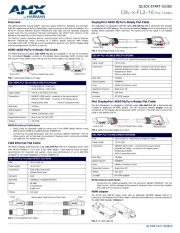
11 Juni 2025
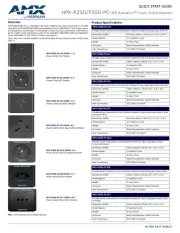
10 Juni 2025
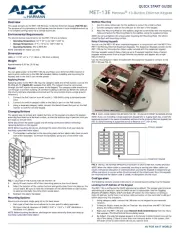
9 Juni 2025
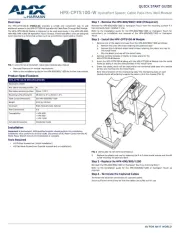
9 Juni 2025
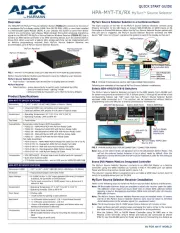
9 Juni 2025
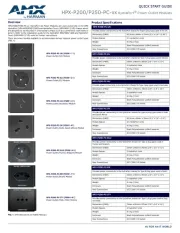
9 Juni 2025
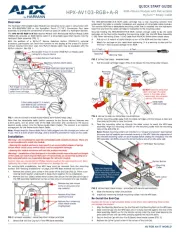
9 Juni 2025
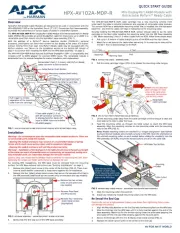
9 Juni 2025

9 Juni 2025

9 Juni 2025
Handleiding Niet gecategoriseerd
- Vitek
- BBQ Premium
- Earbreeze
- Atech Flash Technology
- Eltra
- Singer
- NordicTrack
- Hoymiles
- Little Giant
- LituFoto
- EOTech
- Coors Light
- Kingston
- Hubelino
- Morrison
Nieuwste handleidingen voor Niet gecategoriseerd
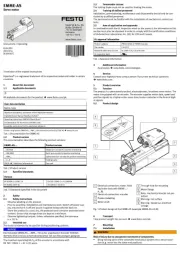
1 Augustus 2025
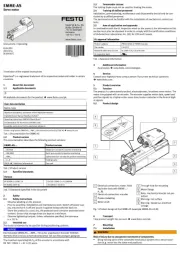
1 Augustus 2025
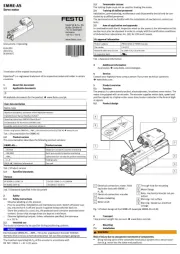
1 Augustus 2025
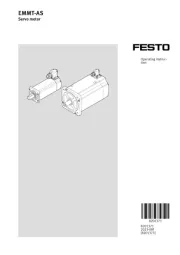
1 Augustus 2025
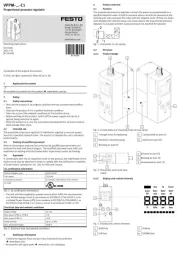
1 Augustus 2025
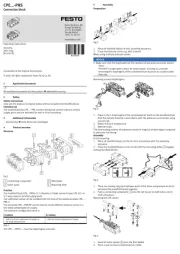
1 Augustus 2025
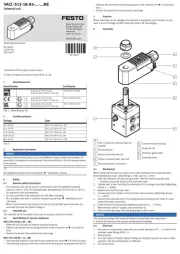
1 Augustus 2025
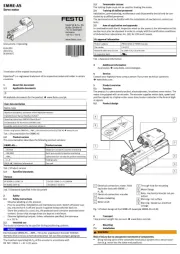
1 Augustus 2025
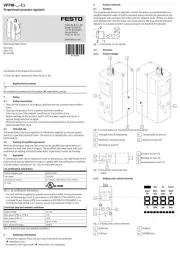
1 Augustus 2025
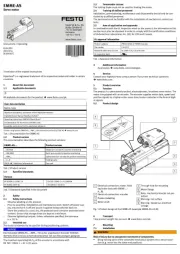
1 Augustus 2025